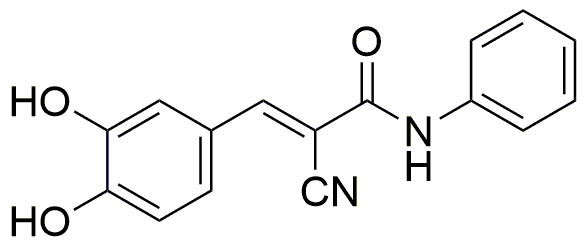Tyrphostin AG 494 is widely utilized in research focused on:
- Cancer Research: This compound serves as a potent inhibitor of specific receptor tyrosine kinases, making it valuable in studying tumor growth and metastasis. Researchers can explore its effects on various cancer cell lines to develop targeted therapies.
- Signal Transduction Studies: Tyrphostin AG 494 helps in understanding cellular signaling pathways by inhibiting key enzymes. This application is crucial for scientists investigating how cells communicate and respond to external stimuli.
- Drug Development: Pharmaceutical companies leverage this compound to screen for potential drug candidates that can modulate kinase activity, leading to innovative treatments for diseases related to dysregulated signaling.
- Neuroscience: The compound is also explored for its neuroprotective properties, offering insights into neurodegenerative diseases. Researchers can assess its impact on neuronal survival and function.
- Biotechnology: In the field of biotechnology, Tyrphostin AG 494 is used to enhance the efficacy of biopharmaceuticals by modulating cell signaling, thus improving the yield and quality of biologics produced in cell cultures.
General Information
Properties
Safety and Regulations
Applications
Tyrphostin AG 494 is widely utilized in research focused on:
- Cancer Research: This compound serves as a potent inhibitor of specific receptor tyrosine kinases, making it valuable in studying tumor growth and metastasis. Researchers can explore its effects on various cancer cell lines to develop targeted therapies.
- Signal Transduction Studies: Tyrphostin AG 494 helps in understanding cellular signaling pathways by inhibiting key enzymes. This application is crucial for scientists investigating how cells communicate and respond to external stimuli.
- Drug Development: Pharmaceutical companies leverage this compound to screen for potential drug candidates that can modulate kinase activity, leading to innovative treatments for diseases related to dysregulated signaling.
- Neuroscience: The compound is also explored for its neuroprotective properties, offering insights into neurodegenerative diseases. Researchers can assess its impact on neuronal survival and function.
- Biotechnology: In the field of biotechnology, Tyrphostin AG 494 is used to enhance the efficacy of biopharmaceuticals by modulating cell signaling, thus improving the yield and quality of biologics produced in cell cultures.
Documents
Safety Data Sheets (SDS)
The SDS provides comprehensive safety information on handling, storage, and disposal of the product.
Product Specification (PS)
The PS provides a comprehensive breakdown of the product’s properties, including chemical composition, physical state, purity, and storage requirements. It also details acceptable quality ranges and the product's intended applications.
Certificates of Analysis (COA)
Search for Certificates of Analysis (COA) by entering the products Lot Number. Lot and Batch Numbers can be found on a product’s label following the words ‘Lot’ or ‘Batch’.
*Catalog Number
*Lot Number
Certificates Of Origin (COO)
This COO confirms the country where the product was manufactured, and also details the materials and components used in it and whether it is derived from natural, synthetic, or other specific sources. This certificate may be required for customs, trade, and regulatory compliance.
*Catalog Number
*Lot Number
Safety Data Sheets (SDS)
The SDS provides comprehensive safety information on handling, storage, and disposal of the product.
DownloadProduct Specification (PS)
The PS provides a comprehensive breakdown of the product’s properties, including chemical composition, physical state, purity, and storage requirements. It also details acceptable quality ranges and the product's intended applications.
DownloadCertificates of Analysis (COA)
Search for Certificates of Analysis (COA) by entering the products Lot Number. Lot and Batch Numbers can be found on a product’s label following the words ‘Lot’ or ‘Batch’.
*Catalog Number
*Lot Number
Certificates Of Origin (COO)
This COO confirms the country where the product was manufactured, and also details the materials and components used in it and whether it is derived from natural, synthetic, or other specific sources. This certificate may be required for customs, trade, and regulatory compliance.

